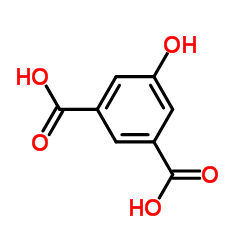5-Hydroxyisophthalic acid

5-Hydroxyisophthalic acid structure
|
Common Name | 5-Hydroxyisophthalic acid | ||
|---|---|---|---|---|
| CAS Number | 618-83-7 | Molecular Weight | 182.130 | |
| Density | 1.6±0.1 g/cm3 | Boiling Point | 516.9±45.0 °C at 760 mmHg | |
| Molecular Formula | C8H6O5 | Melting Point | 298-302 °C(lit.) | |
| MSDS | USA | Flash Point | 280.5±25.2 °C | |
| Symbol |

GHS07 |
Signal Word | Warning | |
|
Application of stripping voltammetry to trace lead analysis in intermediates and final products of syntheses of pharmaceuticals.
J. Pharm. Biomed. Anal. 14(7) , 765-71, (1996) Applications of differential pulse anodic stripping voltammetry using a new pen-type renewed hanging mercury electrode have been investigated for trace analysis of lead in pharmaceutical substances and intermediates of their syntheses, such as procaine hydroc... |
|
|
[Information from the Soviet Toxicology Center].
Gig. Tr. Prof. Zabol. (2) , 52-3, (1983)
|
|
|
Two 3D chiral coordination polymers with 4-connected 6(6) topological net: synthesis, structure and magnetic properties.
Dalton Trans. (44) , 9807-11, (2009) The hydrothermal reaction of Co(II)/Cu(II), 5-hydroxyisophthalic acid and dipyridophenazine leads to the generation of two 3D chiral coordination polymers, [M(hip)(DPPZ)](n) (M = Co(), Cu(), H(2)hip = 5-hydroxyisophthalic acid, DPPZ = dipyridophenazine), whic... |
|
|
Dicarboxylate-bridged (Mo2)n (n = 2, 3, 4) paddle-wheel complexes: potential intermediate building blocks for metal-organic frameworks.
Dalton Trans. 40(43) , 11490-6, (2011) The treatment of the dimeric paddle-wheel (PW) compound [Mo(2)(NCCH(3))(10)][BF(4)](4)1 with oxalic acid (0.5 equiv.), 1,1-cyclobutanedicarboxylic acid (1 equiv.), 5-hydroxyisophthalic acid (1 equiv.) (m-bdc-OH) or 2,3,5,6-tetrafluoroterephthalic acid (0.5 or... |
|
|
Mechanistic evaluation of factors affecting compound loading into ion-exchange fibers.
Eur. J. Pharm. Sci. 31(5) , 306-17, (2007) Donnan theory was applied to gain mechanistic understanding on the factors affecting drug loading process, compound-fiber affinity and subsequent release from fibrous ion-exchangers. Impact of initial loading solution concentration on fiber occupancy and load... |
|
|
The effect of valence on the ion-exchange process: theoretical and experimental aspects on compound binding/release.
J. Pharm. Sci. 96(1) , 117-31, (2007) The effect of valence of mobile counter-ions (extracting electrolytes), mobile co-ions, and drug-like compounds was evaluated on drug binding/release in ion-exchange fibers. The experimental results support the Donnan theory and suggest that incorporation of ... |
|
|
Microbial conversion of 5-sulfoisophthalic acid into 5-hydroxyisophthalic acid by Ochrobactrum anthropi S9.
Biotechnol. Lett. 32(3) , 445-50, (2010) 5-Hydroxyisophthalic acid-producing microorganisms were isolated from enrichment cultures using 5-sulfoisophthalic acid as a sulfur source. One bacterium, Ochrobactrum anthropi S9, had the highest 5-sulfoisophthalic acid-degrading activity, and stoichiometric... |